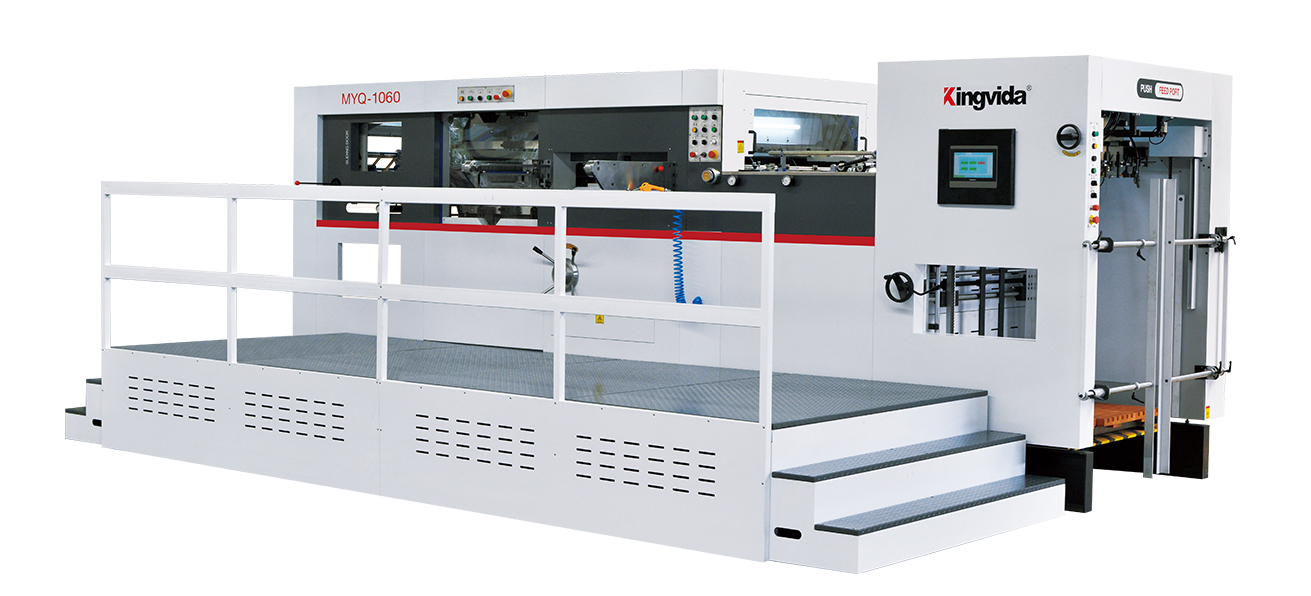What is die-cutting?
Die cutting is a mass manufacturing process where shapes are cut by shearing raw materials such as paper and chipboard using a die, a specially made tool used to cut or shape materials. The die has sharp edges to pierce the material; and has the two-dimensional shape of a finished part. The die-cutting process works on the same principle as a cookie cutter that cuts dough into smaller sizes. Materials that can be die cut include paper, fabric, rubber, fiberglass, sheet metal, foam, wood, and plastic.

Automatic die cutting creasing machine with stripper
What is the purpose of a die cutter?
Although die cutters vary (you will need to read the machine specifications before purchasing), all die cutters will cut paper. Most can cut felt, foam, thin fabrics and vinyl, although it is important to note that only steel rule dies can cut chipboard. Some can even cut corkboard, leather, rubber, and sponge!
Die cutters can be used to make stickers, envelopes, stand-up cards, gift tags, snack bags, party favors, shaker cards, pillowcases, and much more. They are used by card makers, scrapbookers, papermakers, stitchers, and general crafters. They are even used in classrooms to facilitate learning and create projects.
The 5 most popular die-cutting machines
We understand that there are hardly ever any one-size-fits-all solutions when it comes to die cutting. Because of this, we utilize a myriad of different die cutting methods and machines to ensure we match your needs to the best and most cost-effective solution. Let’s take a quick look at five of the most popular die cutting machines.
Flatbed Types of Die Cutting Machine
The flat bed type of die cutting machine utilizes a range of different hydraulic pressures to create shapes and other precise cuts with a steel rule die. This type of die cutting machine is excellent for making die cuts to laminates and sheets, precise kiss cuts, and butt cuts. A few key benefits of using flatbed types of die cutting machines include:
● Much higher flexibility on the design,
● Lower costs of tooling, and
● Greater ability to die cut thicker elastomers or materials.
If your project involves different types of shapes or no material curvature is required, flatbed types of die cutting machines may be ideal. Most notably, flatbed types of die cutting machines are more cost effective at creating low volume orders.
Laser Types of Die Cutting Machines
Laser types of die cutting machines are more modern and the go-to choice for projects that require the unique combination of speed and accuracy. Laser die cutting equipment applies a fully-focused, non-thermal ray to seamlessly die cut nonmetallic elastomers into a virtually endless array of components or industrial gaskets of any shape or size. Unlike other types of “die” cutting, the laser process doesn’t use a physical die.
Instead, the laser is guided and controlled by a computer under the instruction of a CAD generated design. In addition to offering exceptional accuracy and speed, laser types of die cutting machines are perfect for creating one-off cuts or initial prototypes.
This type of machine also works well with die cutting and shaping tougher materials that would be unmanageable on other types of die cutting machines. In either case, laser die cutting machines are very popular because of their versatility, rapid turnaround time, and excellent suitability for high volume/short run production.
Water Jet Types of Die Cutting Machines
Similar to laser die cutting, water jet types of die cutting equipment doesn’t use a physical die. Instead, it uses a highly-pressurized stream of water moving rapidly — up to twice the sound of speed. Water jet die cutting machines also use CAD to guide the stream of water through the elastomer to create the desired shape.
This jet stream of water is released through a very tiny opening and creates a stream powerful enough to cut through a myriad of different materials — even steel. Water jet die cutting is a very high precision and versatile cold cutting process, and the maintenance costs typically remain low. Laser jet types of die cutting machines are commonly used in industrial processes where precision is critical.
Rotary Types of Die Cutting Machines
The rotary types of die cutting machines use a die that all other components in the run will be copied from. Because of this, it’s imperative the initial die is of the right specifications. The rotary type of die cutting machine is engineered with a cylindrical anvil. As the nonmetallic material is fed through the machine, the die seamlessly makes a series of accurate and quick cuts to create the desired shape or component.
Press Types of Die Cutting Machines
Press types of die cutting machines are very versatile — ranging from extremely large versions down to more personal, compact models. As the name suggests, press types of die cutting machines usually involve the die being raised and lowered upon the forming material, which is supported by a flat surface or table.
The actual cutting action of the die can be managed by pressurized sources, hydraulic sources, electric sources, or even manual sources. Depending on the application and other factors, the die can cut and create a single piece of material, or the elastomer to be cut can be stacked to create several different copies at a time.
Want to know more?
If you are looking for the perfect Die Cutting Machine, check out KINGVIDA Die Cutting Systems and visit https://www.kingvida.com/. Welcome to contact us today or request a quote.
评论
发表评论